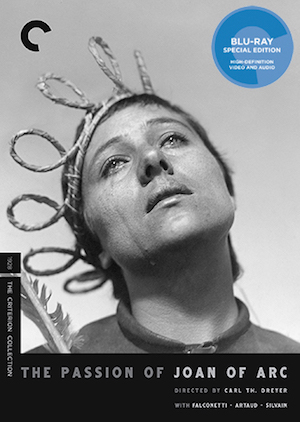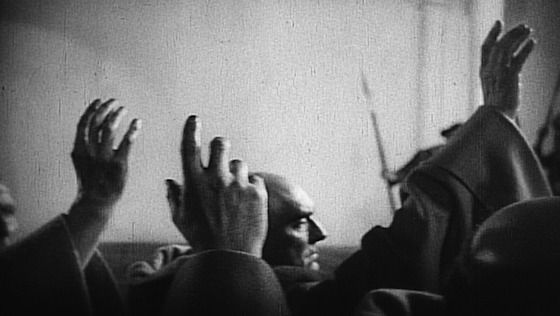One of the most fascinating aspects of the definitive Blu-ray edition (new to The Criterion Collection) of Carl Theodor Dreyer‘s undisputed silent film masterpiece The Passion of Joan of Arc is the argument that almost all of the people who have viewing the film since its debut 90 years ago may have been watching it at the wrong speed.
You see, the majority of silent films back then were hand-cranked. Some projectionists would show movies at faster rates to give it “snap,” but often filmmakers assumed, and probably rightly so, that it was so they could fit more showings into a day.
One one of the Blu-ray’s superlative extra features examining the legacy of this astounding movie, which seems to exist out of time, film scholar Casper Tybjerg says he thinks the proper frame rate was probably meant to be 20 frames per second, although he admits the although evidence isn’t conclusive either way. The Blu-ray contains the 20 fps version, which has a slower pace to fit the film’s somber tone. This version is accompanied by a 2005 piano score by Mie Yanashita.
Of course, the frame rate of sound projectors was standardized (at 24 fps) because the picture and sound needed to be synchronized. Since that happened, most audiences have seen this version. The options for the score in this version, which also appears in a newly restored 2K presentation, are quite different. Adrian Utley from Portishead and Will Gregory from Goldfrapp have a contemporary post-rock take on it in their 2010 score, while Richard Einhorn’s 1994 oratorio Voices of Light is on the other soundtrack of the 24 fps version.
In fact, depending on when you saw The Passion of Joan of Arc, you may have seen a 100 percent different cut of the movie altogether than what audiences saw in its 1928 premiere in Olso, Norway. The original negative was destroyed in a fire, so Dreyer cut a second negative together using entirely alternate takes from the cutting room floor. This version was then re-edited in 1951 from second negative by an opportunist who replaced also all of the inter-titles with subtitles! Again, thanks to Gaumont for this new 2K restoration, which sees the film resurrected in its original form, as well as Criterion for making it available to anybody.
After all of this fascinating background is out of the way, if you’ve never seen The Passion of Joan of Arc, you’re probably wondering what all the fuss is about. Simply put, this 1928 landmark still has the power to stun today.
During the Hundred Years’ War, Joan of Arc (Renée Falconetti) is captured and brought to Normandy to stand trial for heresy by French clergymen loyal to the English. She is deeply religious but does not recognize their religious authority. They spend most of the movie trying to goad Joan into making a heretical remark about her relationship with God. Interestingly,the scene where the judges try to blackmail Joan by withholding the Sacrament was originally cut after Dreyer showed the film to representatives of the Catholic church in the library of the Notre Dame.
Especially for a movie of its time, The Passion of Joan of Arc is very fast-paced. It contains more than twice the amount of shots and inter-titles of movies of the day, cutting more than twice as much. It’s no surprise then that one of the most important inspirations on Dreyer was Soviet montage, specifically Eisenstein’s Battleship Potemkin.
The Passion of Joan of Arc consistently violates the traditional 180 degree sight-line rule, going against all established rules of filmmaking. It’s a disorienting, beautiful, tense movie. One tracking shot is all we get for an establishing shot and it doesn’t even end with Joan. No, she comes in later in another shot, so it’s difficult to orient the action in the spaces the characters inhabit.
People are constantly moving in and out of the frame, the camera pans in all directions, there are close-ups all over the place, and there’s eccentric framing even when they are not technically close-ups. These shots feel like close-ups because each shot will focus on one major element. When it’s not a close-up, the camera is often moving, and the frequent number of low-angle shots give the audience the feeling of someone towering over them.
Although it was filmed in 1928, The Passion of Joan of Arc is required viewing for anyone interested in the language of film. If a filmmaker today applied the same unique rigor to a modern movie, the industry would flip out and call them a genius. That’s how much power this film still holds. We’re lucky that so many versions of it have survived so long so that we can enjoy it and learn from it now.











Comments on this entry are closed.